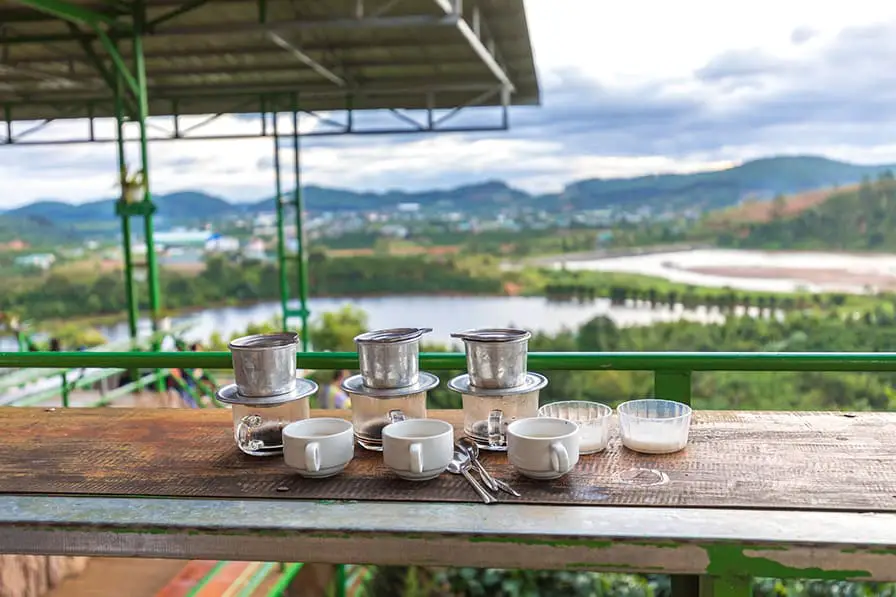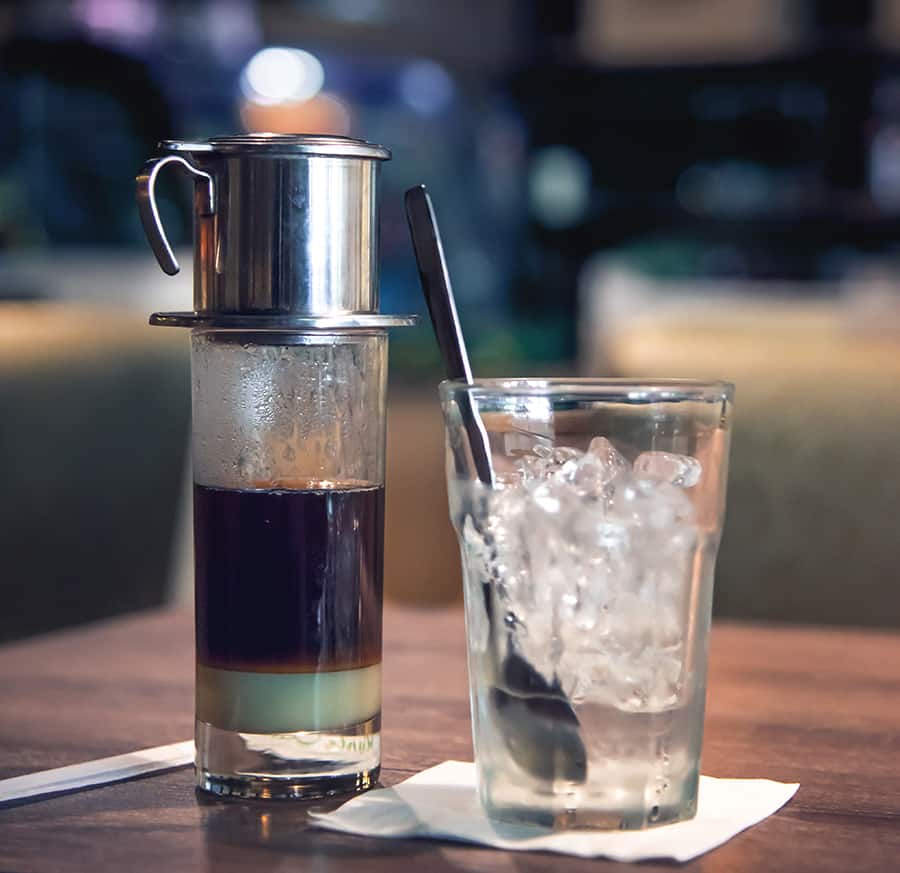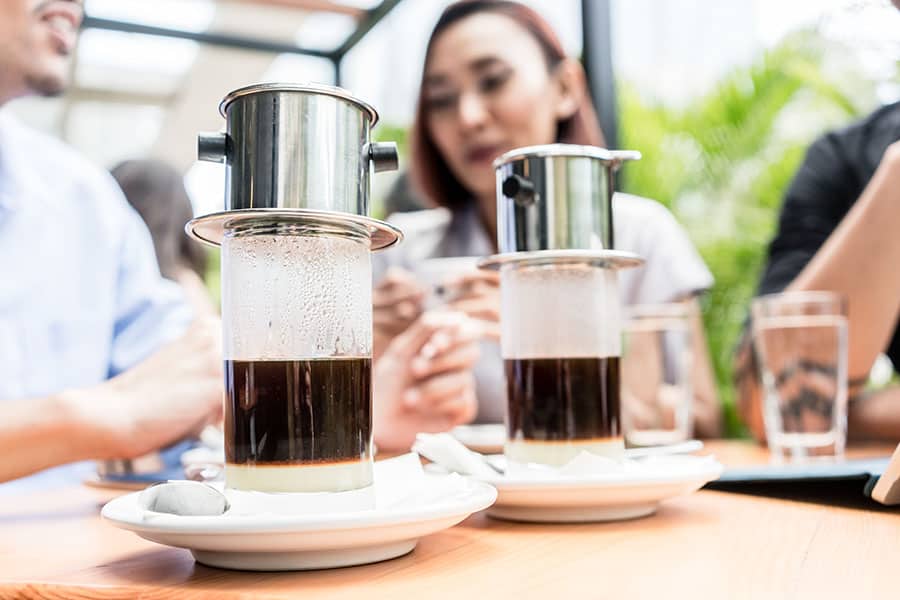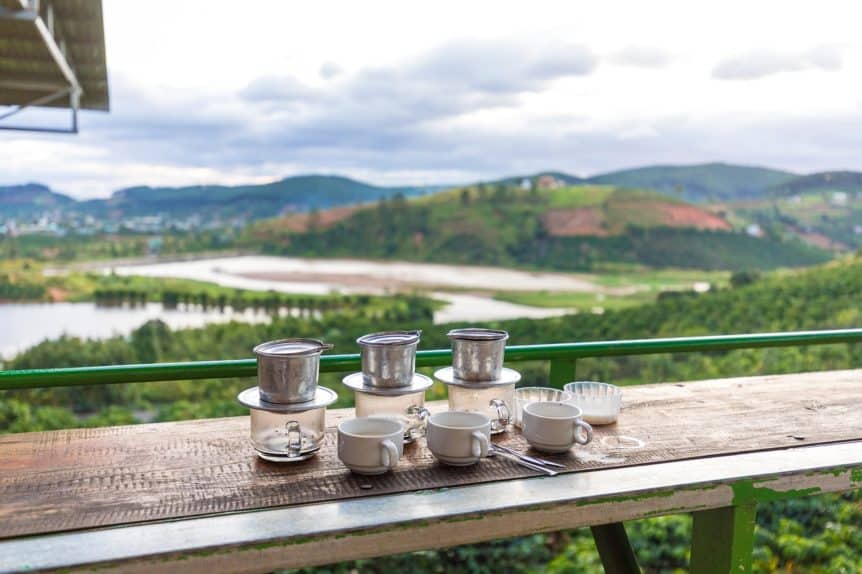
A French priest brought coffee to Vietnam in 1857 in order to start a small business. Shortly thereafter, it became so popular that land was converted to coffee plantations in order to have a steady cash crop. It quickly became a major economic contributor for Vietnam until the war broke out in the 1960’s.
Today it is still an important part of Vietnamese culture and coffee production in the country has rebounded to the point where they are now the 2nd largest producer of coffee in the world.
Early History
In the early history of coffee in Vietnam, the cafés scene in early urban areas of Vietnam divided into the two types. First is the chic French-style cafes for the French and the Vietnamese officers working for the colonial government, who learned the habit to fuel their day with coffee.
Second is the more affordable café served in restaurant or breakfast stalls owned by the Cantonese and other Chinese immigrant groups from Southern China.
Since 1868, there were French-style chic cafes in both largest cities of Vietnam, Saigon, and Hanoi. There were the two centers where the Western lifestyle was first established to serve the French colonizers but later accepted by the local. In 1864, Son Nam wrote, Saigon had two earliest French cafés, which were Lyonnais and Café de Pari.
Vietnamese Coffee and Colonization
In Hanoi, following the colonization of the French in Vietnam after 1958, café were quickly established from 1882, where the French successfully conquered Hanoi to 1885.
On the newspaper Tuong Lai Bac Ky (Future of the North), the issue on 5 August 1885, several cafés were named, such as Café du Commerce, Café de Paris, Café Albin, Café de la Place, Café Block. Those cafés were more the social places for French businessmen and officers than the local mass.
Those cafes most likely also had French owners, for example, Tuong Lai Bac Ky wrote that owner of Café de Beira – one of the earliest cafes – is a retired French woman working in the military cafeteria.
Yet I am convinced that coffee must have gained its popularity more through the Chinese immigrants in the cities. An explanation for my personal conviction lies in the similarity in the pronunciation between how coffee is spelled in Cantonese and Vietnamese, cà phê.
I still vividly remember how surprised I was to hear how coffee was spelled exactly the same like in Vietnam in Cantonese while watching the movie “In the mood for love” by the Hong Kong filmmaker Wong Kar-Wai.
I learned later on through the writing about old Saigon by the writer Son Nam that coffee was served at a more affordable price as an alternative choice to tea in the Chinese restaurants and breakfast street side stalls for the blue-collar workers of Saigon in the early nineteenth century.
The habit of coffee drinking must have been spread from the Chinese quarter Cholon ever since to all over Saigon and replaced tea as the most popular drinks all over the country.
Milk and Vietnamese Iced Coffee

Vietnamese Iced Coffee with milk has its local adaptation in several regions, depending on the tastes, the way it is made, the choice of coffee beans, but also the history of the coffee culture itself.
In Hanoi, it is called “nâu đá” (literally translated as “iced brown”, hinting at the color of the drink) while in Saigon, it is called “cà phê sữa đá” (translated as “iced milk coffee).
Nowadays, the coffee filter is iconic for Vietnamese coffee and ubiquitous for all regions in Vietnam, but there was a time when the coffee filter was only used in the North and Southern Vietnam preferred the “stocking coffee” (“cà phê vợt”). In the latter method, the cloth filter is used to strain coffee ground.
This method was used mostly by Chinese immigrants in Saigon before the end of the Vietnam war in 1975 and served as a quick way to strain coffee compared to the time-consuming filter.
But as a Saigonese, the Vietnamese milk coffee keeps a special place in my heart as a childhood drink.
Traditional Vietnamese Coffee Drinkers
We lived in the periphery of Saigon and when I was small, the area was still covered with trees, which is not the case nowadays, when urbanization hits Saigon hard with the reduction of green space in exchange for high-rise residential buildings to meet the rising demands from the population of nearly 10 million people coming to the city to seek employment opportunities.
Not far from our old house was Dam Sen park (literally mean Lotus Pond), the largest entertainment park in the early 1990s. At the opposite, our house is a small café with a television, quite an attraction for the neighborhood when owning a television used to be a luxury.
My dad usually took me there and let me sit next to him while watching whatever movies were showing on the television. He usually ordered the very thick and black coffee. Once the five-year-old-me had decided to give it a try, of course without the consent of my father.
He was surprised and amused to find out his daughter had finished the whole black and very bitter coffee.
Vietnamese Coffee Today

Nowadays, you can find Vietnamese black coffee and milk coffee everywhere in Vietnam, both at upscale cafes in the city center, small alley vendor and new-style takeaway coffee, as well as outside of Vietnam, in almost every Vietnamese restaurant in America or Europe.
Coffee drinkers in Vietnam are not only the young office workers but also almost every Vietnamese middle-aged man. Drinking coffee early in the morning after breakfast and having a chat with friends has long become a ritual to start a day for many Vietnamese.
When I had a chance to travel outside of Vietnam, I found out that coffee ritual is rather unique to Vietnamese lifestyle.
I was surprised to find out in Guangzhou, a large neighboring city in China next to Hong Kong, a good freshly brewed cup of coffee is only available in Commercial District Area with a high price for young people.
A good coffee cup in China is as hard to find as a baguette, while both are basic commodities in Vietnam. There I have seen a strong French footprint to our culture after their 100 years in our country.
Every Vietnamese coffee drinker is likely a coffee snob with his or her own preference for the café in town and the specific coffee. Once I took my father to my favorite café in Saigon, Ben, in which the coffee beans were handpicked from coffee farms in Nha Trang and freshly brewed in Saigon.
I loved the strong, fresh and honest taste of their coffee, which reminded me of the sunny beaches of Nha Trang. So imagine how I was rather annoyed to see my dad’s expression when he tasted the coffee. “It is too light” is his comment, diplomatically trying not to disappoint me.
His comment, however, leads us to an interesting discussion about our generation gap when it comes to coffee. Of course, I can still vividly remember when he fondly reminded me of the first time I drank coffee.
Final Thoughts
The coffee of that day is no longer in fashion nowadays, as the coffee back then was not pure coffee but was heavily mixed with corn, soya beans and whatever spices that the coffee makers deemed that would enhance the taste. After the Vietnam war ended in 1975, because of the U.S. embargo and the abandon of agriculture, coffee beans suddenly become the rare good.
The solution was to mix the coffee powder with corn and other cheaper and easier to find powder. The coffee liquid is thick, pitch black and dense. My father, who was born in 1960, had drunk that type of coffee all his life and got so used to it that he could not imagine drinking any other type.
Even if he knew his favorite coffee type was mixed with other substances, which I thought very strange, he preferred the mixed coffee over the pure coffee.
Several years ago, pure coffee beans have come back, together with the introduction of Italian coffee made by coffee machines. My generation, who has grown up after the Vietnamese Reform after 1986 and enjoyed the economic boom of the country, quickly adapted to the new type of coffee. Several of my friends love Starbucks more than the local street vendors.
A friend of me claimed that condensed milk destroyed the original taste of coffee and she preferred to drink coffee with fresh milk in the Italian way. I am myself not that picky, or I would take a cappuccino or a café au lait without complaint.
But as a Saigonese, the Vietnamese milk coffee keeps a special place in my heart as a childhood drink.

